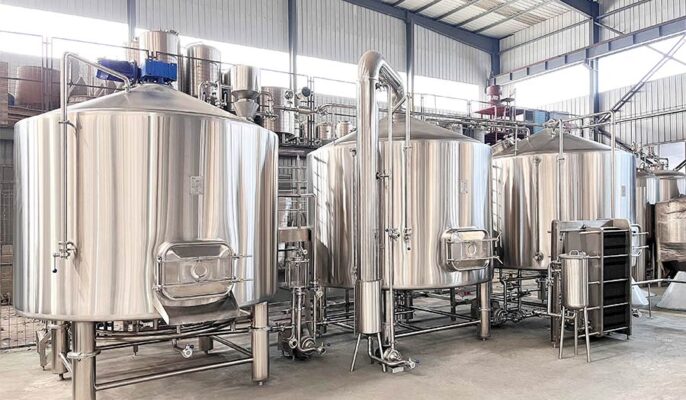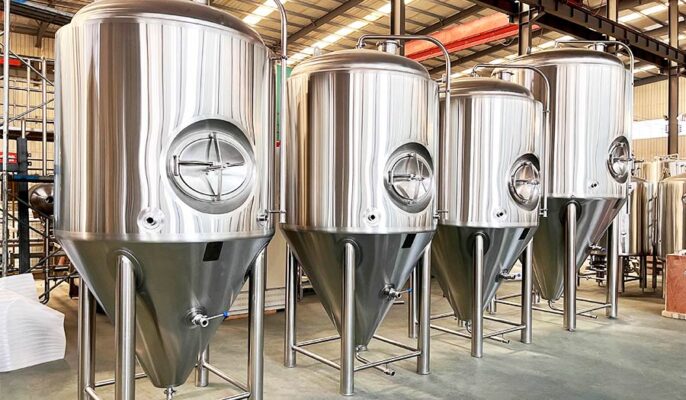商業醸造所を立ち上げるのは、面倒でエキサイティングなことだ。 業務用ビール醸造設備 は欠くことのできない重要な役割を担っている。世界のビール市場が成長と多様化を続ける中、業務用ビール醸造設備の需要も高まっています。当社はビール製造設備の専門メーカーとして、企業が生産効率を向上させ、製品品質を最適化し、市場の需要に応えられるよう、一流のビール醸造設備を提供することをお約束します。
何なのか? 業務用ビール醸造設備?
業務用ビール醸造設備は、大規模なビール製造のために特別に設計された機械やシステムです。これらの機器は、中規模から大規模の醸造所に適しており、ビール醸造プロセスの様々なステップを効率的かつ安定的に完了することができます。家庭用ビール醸造設備や小規模なクラフトビール醸造設備に比べ、業務用ビール醸造設備は処理能力が高く、自動化レベルが高く、品質管理基準が厳しい。

業務用ビール醸造プロセス
粉砕とマッシュ
ビール醸造の旅は、大麦粒を注意深く発芽させ、乾燥させ、焙煎してデンプンと糖分を放出させる麦芽製造から始まる。この麦芽を挽いて、モルトパウダーと呼ばれる粗い粉末にします。麦芽パウダーは麦汁樽の中で熱水と接触し、酵素によってデンプンが発酵可能な糖分に変換され、甘い麦汁ができる。異なる麦汁製造方法、異なる温度、時間によって、異なるビールスタイルのニーズに応えることができる。
ボイルとホッピング
麦汁は鍋に注がれ、激しく煮沸される。ホップはホップ科の植物の球根で、ビールに苦味、香り、安定性を与えるために特定のタイミングで添加される。ホップの品種や添加時期によって、各ビールスタイルの個性が決まる。ビールの苦味と香りを出すために使用される。ホップの鮮度と有効成分を保つためには、乾燥した涼しい環境で保管する必要がある。
発酵
麦汁は冷やされた後、発酵タンクに入れられ、厳選された酵母が加えられる。この驚くべき微生物が糖分をむさぼり、アルコール、二酸化炭素、そしてビール独特の風味を生み出す。発酵の温度と期間は、最終的な風味に大きく影響するため、厳密に管理される。二次発酵の段階では、ビールの風味がさらに増し、酵母やその他の沈殿物が徐々に沈殿していきます。熟成期間は数週間から数ヶ月に及ぶ。
パッケージング
ろ過・清澄化したビールを瓶、缶、樽に充填します。充填工程では、ビールの衛生と密閉性を確保する必要があります。充填工程では、ビールが空気に触れるのを防ぎ、鮮度と味を保つために、高精度の充填機と密封機が使用されます。
ビールの種類 醸造設備
麦汁樽
ビール醸造工程の中で、主に麦汁(もろみ後の液体麦汁)を扱う重要な設備。麦汁樽は「麦汁タンク」や「ウォートタンク」と呼ばれることもあり、その機能とデザインはビールの品質と生産効率を確保するために非常に重要です。麦汁樽は、もろみ工程が終了した後、もろみ汁を保持し、取り扱うために使用されます。麦汁樽は、さらに煮沸または冷却するためにろ過された液体麦汁を受け入れることができます。
ブリューケトル
麦汁を煮沸し、ホップなどの調味料を加えるために使用されます。醸造釜の設計と機能は、ビールの風味、品質、生産効率に直接影響する。糖化した麦汁を沸点まで加熱して微生物を死滅させ、麦汁の生味を除去し、麦汁を濃縮する。沸騰させる過程で麦汁中のフェノール物質が除去され、ビールの苦味が減少し、ホップの芳香成分と苦味成分が放出される。
フィルタータンク
フィルタータンクは、糖化された麦芽混合物から麦汁(液体)と麦芽残渣(固体)を分離するために使用されます。フィルタータンクの設計と機能は、麦汁の透明度と品質に直接影響するため、効率的で高品質なビールを製造するための中核設備の1つです。フィルタータンクの主な役割は、物理的な濾過によって糖化混合物中の液体麦汁から固体麦芽残渣を分離することです。良好な分離工程は、透明な麦汁を得、沈殿物を減らし、ビールの味と外観を改善することができます。
発酵タンク
発酵タンクは、酵母が発酵し、糖分をアルコールと炭酸ガスに変換し、さまざまなフレーバー化合物を生成するために、密閉され制御された環境を提供します。発酵中の温度、圧力、時間をコントロールすることで、ビールの風味と品質が保証される......発酵タンクの設計と機能は、ビールの味、香り、全体的な品質に直接影響する。
明るいタンク
ブライトタンクは、発酵した液体を貯蔵し、製品の安定性と品質を確保し、その後の包装加工に備えるために使用される。ブライトタンクは、液体に熟成環境を提供し、風味と味を改善し、完成させます。適切な貯蔵条件は、風味の融合と熟成を促進し、製品全体の品質を向上させる。ブライトタンクは飲料製造工程で重要な役割を果たし、その設計と機能は製品の安定性と品質に直接影響します。
麦汁クーラー
煮沸した麦汁を発酵に必要な温度まで素早く冷却する。冷却はビールの品質、風味、健康状態に影響する、醸造工程における重要なステップです。効果的な冷却は、ビールの安定性と透明性を確保するだけでなく、冷却の遅れによる細菌汚染や風味の劣化を防ぎます。
充填システム
ビールを貯蔵タンクからボトル、缶、その他の容器に移し、パッケージングプロセスの効率性と正確性を確保します。効率的な充填システムは、製品の無駄を省くだけでなく、各瓶ビールの安定した品質を保証します。最新の充填システムは通常、自動化技術を統合しており、液面、充填速度、容器の密封を正確に制御する機能により、生産効率と製品の衛生・安全性を向上させます。優れた充填システムの設計は、酸素の侵入を減らし、それによってビールの酸化を避け、風味と鮮度を維持し、生産ラインの全体的な作業効率を向上させることができます。
洗浄システム
洗浄システムは、生産設備やパイプラインを分解することなく、徹底的に洗浄・消毒することを保証します。効率的な洗浄システムは、装置内の残留物、沈殿物、微生物を効果的に除去し、生産環境の衛生と安全、製品品質の安定を保証します。定期的な洗浄と消毒により、洗浄システムは生産ラインの運転効率を向上させるだけでなく、装置の耐用年数を延ばし、二次汚染や製品品質の問題を回避します。

|
設備 |
説明 |
|
ブリューケトル |
澱粉を糖に変え、穀物から風味や色を抽出するために、麦芽を熱水に浸す大型のステンレス製タンク。 |
|
ラウター・チューン |
使用済み穀物から甘い麦汁を分離するスパージングプロセス |
|
マッシュフィルター |
マッシュタンとロータータンを組み合わせ、効率的なエキス分離を実現 |
|
ブリューハウス |
醸造用容器の総称 - マッシュ・タン、ラウター・タン、ケトル |
|
発酵槽 |
ビール発酵用の密閉された温度制御容器 |
|
ケグウォッシャー |
樽の洗浄・消毒用高温高圧洗浄機 |
よくあるご質問
業務用ビール醸造設備とは?
業務用ビール醸造設備とは、麦汁樽、発酵タンク、ろ過システム、麦汁冷却器、充填システム、洗浄システムなど、大規模なビール製造に使用される機械や設備を指します。これらの設備は、ビール製造工程が効率的に行われ、品質基準を満たすように連携しています。
なぜ発酵タンクの温度管理が重要なのか?
温度が異なると酵母の活性や発酵速度に影響し、ビールの風味や品質に影響するため、温度管理は発酵プロセスにおいて非常に重要です。適切な温度管理は、不快な風味の発生を防ぎ、発酵の安定性と一貫性を保証します。
ろ過システムはどのようにしてビールの品質を向上させるのですか?
濾過システムは、麦汁から固体粒子、沈殿物、不純物を除去することによってビールの液体を透明化し、外観と味を改善するのに役立ちます。優れた濾過システムは、沈殿物を減らし、ビールの安定性と保存性を向上させることもできます。




